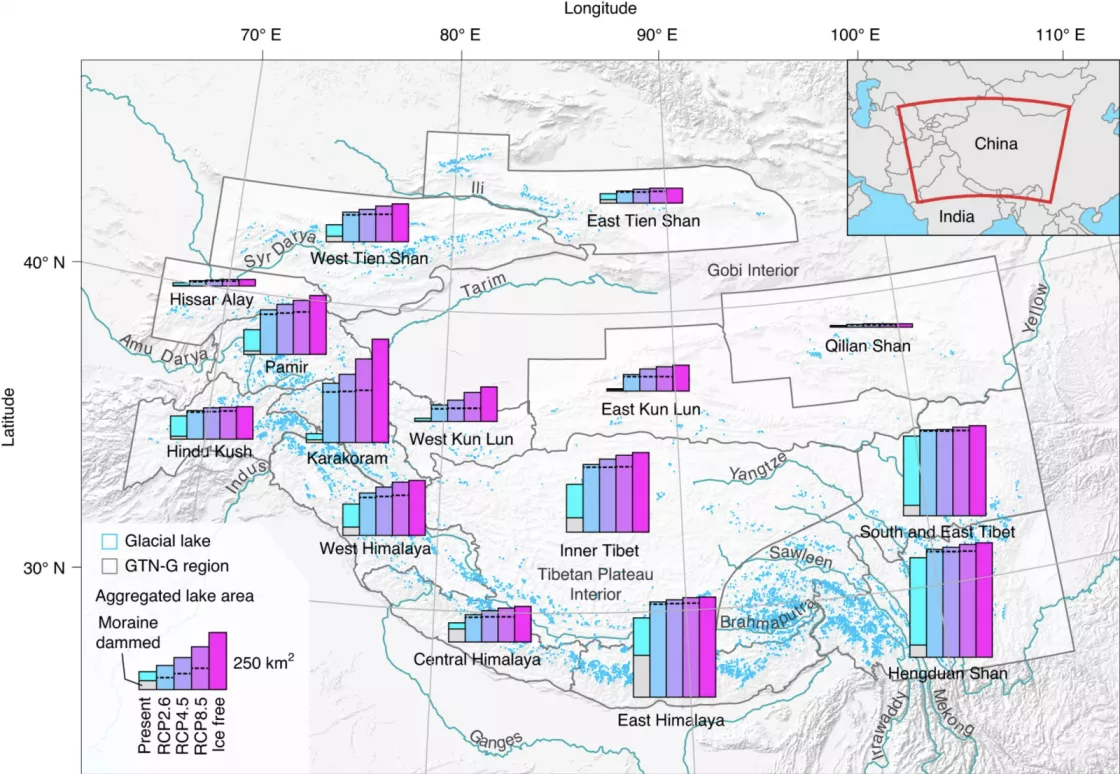By Agnieszka Gautier
A glacial lake is a body of water that originates from a glacier. It typically forms at the foot of a glacier, but may form on, in, or under it. As Earth’s climate warms, the world’s glaciers are shrinking, increasing freshwater outputs to all kinds of glacial lakes. Some communities depend on glacial meltwater for seasonal irrigation or domestic use, but as the balance shifts toward more melt, this water source may not be reliable in the long term and comes with new risks.
How glacial lakes form
As glaciers move, they erode the terrain under them, leaving depressions and grooves on the land. When they churn up rock and soil, they etch ridges of debris known as moraines. Most glacial lakes form when a glacier retreats and meltwater fills the hole left behind. However, natural dams, formed out of ice and terminal moraines, can also form glacial lakes. An ice dam forms when a surging glacier, which can move up to 100 times faster than an average glacier, may dam up meltwater as it closes off a valley or fjord and prevents it from draining. Dams formed by moraines can be dense and stable, holding sizable lakes behind them for years. They can also be leaky, allowing the lake to drain slowly into nearby rivers. However, prolonged melting or abrupt bursts of intense melting can wreak havoc. Too much meltwater in a short period of time might overflow a lake or burst through natural barriers, flooding lands downstream, washing away communities, and damaging roads and infrastructure. Lakes held back by moraines pose a serious threat because the porous moraine walls can destabilize easily. A rise in the amount of meltwater from glaciers increases the water pressure on the moraine barriers, which can quickly give way and threaten inundation.
Bursting with potential…energy
From 1990 to 2018, satellite images reveal a rise of the number of glacial lakes by 53 percent. The fastest growing lakes are in Scandinavia, Iceland, and Russia, but their volume is relatively small compared to other regions. While these glacial lakes supply fresh water, without a safe drainage system, these same lakes may burst. An outburst flood is the sudden surge of meltwater when a glacial lake's moraine- or ice-dam fails.
The scientists in the study noted that outburst floods threaten hydroelectric power plants in the Himalayas; the Karakoram highway—a billion-dollar corridor of trade between China and Pakistan; and the Trans-Alaska pipeline, which traverses mountains with many glacial lakes. An outburst flood could rupture oil-filled pipelines, creating an environmental disaster.
A 2021 study confirms that the area at greatest risk for glacial outburst floods is centered in the eastern Himalaya, posing life-threatening scenarios downstream. The eastern Himalayas, which are at a lower latitude than the western Himalayas, are relatively warmer. Scientists show that this area is currently twice as likely to have glacial outburst floods as adjacent regions. However, as warming continues, threats may triple by 2050, with more hot spots emerging farther west.
Examples of glacial outburst floods
In spring 1986, Hubbard Glacier in Alaska surged and blocked the outlet of Russell Fjord, entrapping a large lake. Over the summer, snowmelt continued to fill the lake. In October, the glacier-created dam gave way. The fjord reconnected to the ocean, only after releasing 1.3 cubic miles of water, a gush equivalent to about 35 Niagara Falls. This is the largest lake outburst in history.
In 1941 in Peru, up to 5,000 people perished after an earthquake sent a chunk of glacial ice into Lake Palcacocha, causing a flood wave to crash into the town of Huaraz below. Since then, glacial melt has bloated the lake. Pumps have been put in place to reduce the lake's level, but this may not be enough to prevent a future flood. As of 2021, about 50,000 people live in the danger zone in Huaraz.
One example of recurring danger is Chile’s Cachet II Lake, dammed by Colonia Glacier. In 2008, the glacier’s melting ice front failed, draining the lake in a matter of hours. The massive amount of water overflowed the Baker River, which suddenly tripled in flow rate, flooding communities downstream. In less than two days, roads, buildings, and farms were devastated, and many livestock drowned.
Many places in the Andes, Himalayas, and Alaska currently lack a warning system to notify communities of impending glacial lake outburst floods. While they constitute a growing concern, glacial lakes are a natural part of the glacial process. However, in a world of increasing temperatures and human population, flooding is a growing concern.
At the Colonia Glacier, local villagers now have an alarm system that gives them and their livestock eight hours to head to higher ground. But not all communities are fortunate enough to have this kind of warning. Communities that lie downstream of melting glaciers around the world should prepare for more frequent and sudden flooding.
Watch a video about researchers documenting glacial lakes in Nepal's Hongu River Valley, located high in the Himalaya Mountains
References
Shugar, D. H., A. Burr, U. K. Haritashya, et al. 2020. Rapid worldwide growth of glacial lakes since 1990. Nature Climate Change, 10, 939–945. doi:10.1038/s41558-020-0855-4.
Westoby, M. J., N. F. Glasser, M. J. Hambrey, J. Brasington, J. M. Reynolds, and M. A. A. Hassan. 2014. Reconstructing historic Glacial Lake Outburst Floods through numerical modelling and geomorphological assessment: Extreme events in the Himalaya. Earth Surface Processes and Landforms, 39, pages 1675–1692, doi:10.1002/esp.3617.
Zheng, G., S. K. Allen, A. Bao, et al. 2021. Increasing risk of glacial lake outburst floods from future Third Pole deglaciation. Nature Climate Change, 11, 411–417. doi:10.1038/s41558-021-01028-3.



